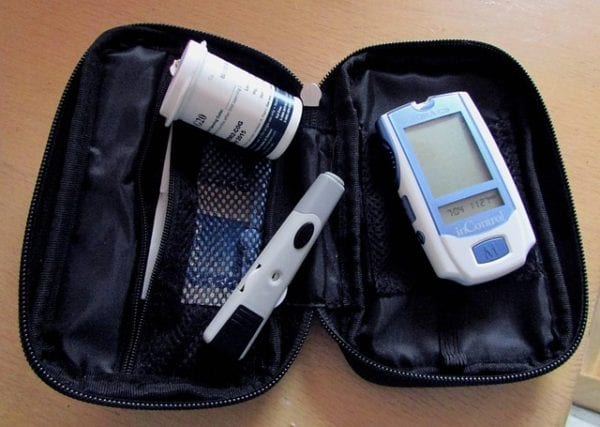Glucagon-like peptide-1 receptor agonists, or GLP-1s, are a highly appealing, newer class of medications for the treatment of type 2 diabetes. Through their activity at the GLP-1 receptor, they slow gastric emptying and decrease glucagon secretion. They also increase the body’s endogenous insulin production, but they do not have as high of a risk for hypoglycemia as some of the older (i.e. sulfonylureas) agents. Further reading on how this affects pre- versus post-prandial blood sugar found here. There are now a handful of agents of this class on the market, all but one of which are exclusively available as subcutaneous injections: dulaglutide (Trulicity), exenatide IR (Byetta), exenatide ER (Bydureon), liraglutide (Victoza), lixisenatide (Adlyxin), and semaglutide (subQ – Ozempic, oral – Rybelsus (podcast episode)). Their doses are usually started low and titrated up to achieve maximum efficacy and most do not require dose adjustments in patients with renal or hepatic insufficiency. The slow titration can help with the tolerability as nausea is a common class adverse effect. The GLP-1 agonist comparison table below highlights some of the key differences between these agents.
| Agent | Indication(s) | Dose | Dose reductions & other considerations |
| Daily Agents | |||
| Exenatide IR | T2DM | 5-10mcg twice daily | Must be given within 60 minutes before AM and PM meals CrCl 50-80: No adjustment CrCl < 30: Not recommended |
| Liraglutide | T2DM T2DM+CV disease Obesity | 0.6mg daily x 1 week then 1.2 – 1.8 mg QD 3 mg daily (as Saxenda for weight loss only) | No dose adjustments in renal or hepatic insufficiency. Use with caution in ESRD and hepatic impairment. |
| Lixisenatide | T2DM | 10mcg QD x 2 weeks then 20mcg daily | Must be given within 1 hour prior to meal GFR 30-89: No adjustment GFR < 15: Not recommended |
| Semaglutide (oral) | T2DM | 3mg daily x 30 days, then 7-14mg daily | |
| Weekly Agents | |||
| Dulaglutide | T2DM T2DM+CV disease | 0.75 – 1.5mg weekly | No adjustment in ESRD Caution in hepatic impairment |
| Exenatide ER | T2DM | 2mg weekly | CrCl < 30: Not recommended ESRD: Not recommended |
| Semaglutide (subQ) | T2DM T2DM+CV disease | 0.25mg weekly |
As noted in the GLP-1 agonist comparison table, in addition to FDA approval for T2DM alone, three of the currently available GLP-1s have been approved for the treatment of cardiovascular disease in the setting of type 2 diabetes. Studies have shown that they can decrease the risk of death due to cardiovascular events and can slow the progression of kidney disease. As a result, ADA and AACE guidelines list them as preferred agents (along with SGLT2s) for this patient population.
Semaglutide is the only agent currently available in both oral and injectable dosage forms. One of the biggest deciding factors for patients can be the dosing frequency which is noted in the comparison table above. For example, class originator exenatide IR is injected twice daily, while several of these agents are injected once weekly. Fewer needle sticks can often mean less pain and more convenience. Cost is also a major issue for patients, as insurance copays on GLP-1s are often quite expensive.
Of note, liraglutide is available as a separate brand name, Saxenda, which is indicated for weight loss in the setting of obesity. It is also notable that brand name exenatide ER is now available in the Bydureon B-Cise pen, which has replaced the original Bydureon pen and is intended to be easier for patients to use. Additionally, lixisenatide and liraglutide are available in combination pens with long-acting insulin under the brand names of Soliqua and Xultophy. I haven’t seen these utilized very often in clinical practice. Possible candidates include patients already on basal insulin to minimize the number of injections.
As a result of the slowed gastric emptying, it is possible for GLP-1s to reduce the absorption of oral medications. All GLP-1s have the potential to cause nausea, vomiting, diarrhea, and other severe GI issues, pancreatitis, headache, dizziness, hypersensitivity and anaphylaxis, and injection site pain. When used alone, the risk for hypoglycemia is generally low, but when used in combination, particularly with insulin or sulfonylureas, hypoglycemia is possible. Generally, all GLP-1s are contraindicated in patients with multiple endocrine neoplasia syndrome type 2 (MEN2) and those with a personal or family history of medullary thyroid carcinoma
Written by Meredith Grunig, PharmD Candidate in collaboration with Eric Christianson, PharmD
- 30 medication mistakes PDF
- 18+ Page Drug Interaction PDF
- 10 Commandments of Polypharmacy Webinar based on my experiences in clinical practice
Study Materials and Resources For Healthcare Professionals and Students – Amazon Books
References:
Micromedex
Glucagon-Like Peptide-1 (GLP-1) Analogues. In: LiverTox: Clinical and Research Information on Drug-Induced Liver Injury. Bethesda (MD): National Institute of Diabetes and Digestive and Kidney Diseases; 2012.
American Diabetes Association. Clinical practice guidelines. Standards of Medical Care in Diabetes – 2020, 43. Arlington (VA). 2020.
American Association of Clinical Endocrinologists and American College of Endocrinology. Diabetes Management Algorithm. Endocrine Practice, 26(1); 2020.
Product information: Dulaglutide (Trulicity) [package insert]. Eli Lilly. Indianapolis, IN 2017. https://www.accessdata.fda.gov /drugsatfda_docs/label/2017/125469s007s008lbl.pdf.
Product information: Exenatide (Byetta) [package insert]. Amylin Pharmaceuticals, Inc. San Diego, CA 2009. https://www.accessdata. fda.gov/drugsatfda_docs/label/2009/021773s9s11s18s22s25lbl.pdf.
Product information: Exenatide ER (Bydureon) [package insert]. Amylin Ohio, LLC. West Chester, OH 2017. https://www.accessdata. fda.gov/drugsatfda_docs/label/2018/022200s026lbl.pdf.
Product information: Liraglutide (Victoza) [package insert]. Novo Nordisk Inc. Plainsboro, NJ 2017. https://www.accessdata.fda .gov/drugsatfda_docs/label/2017/022341s027lbl.pdf.
Product information: Lixisenatide (Adlyxin) [package insert]. Sanofi Aventis, LLC. Bridgewater, NJ 2016. https://www.accessdata .fda.gov/drugsatfda_docs/label/2016/208471Orig1s000lbl.pdf.
Product information: Semaglutide (Ozempic) [package insert]. Novo Nordisk Inc. Plainsboro, NJ 2017. https://www.accessdata .fda.gov/drugsatfda_docs/label/2017/209637lbl.pdf.
Product information: Semaglutide (Rybelsus) [package insert]. Novo Nordisk Inc. Plainsboro, NJ 2017. https://www.accessdata .fda.gov/drugsatfda_docs/label/2019/213051s000lbl.pdf.



0 Comments
Trackbacks/Pingbacks